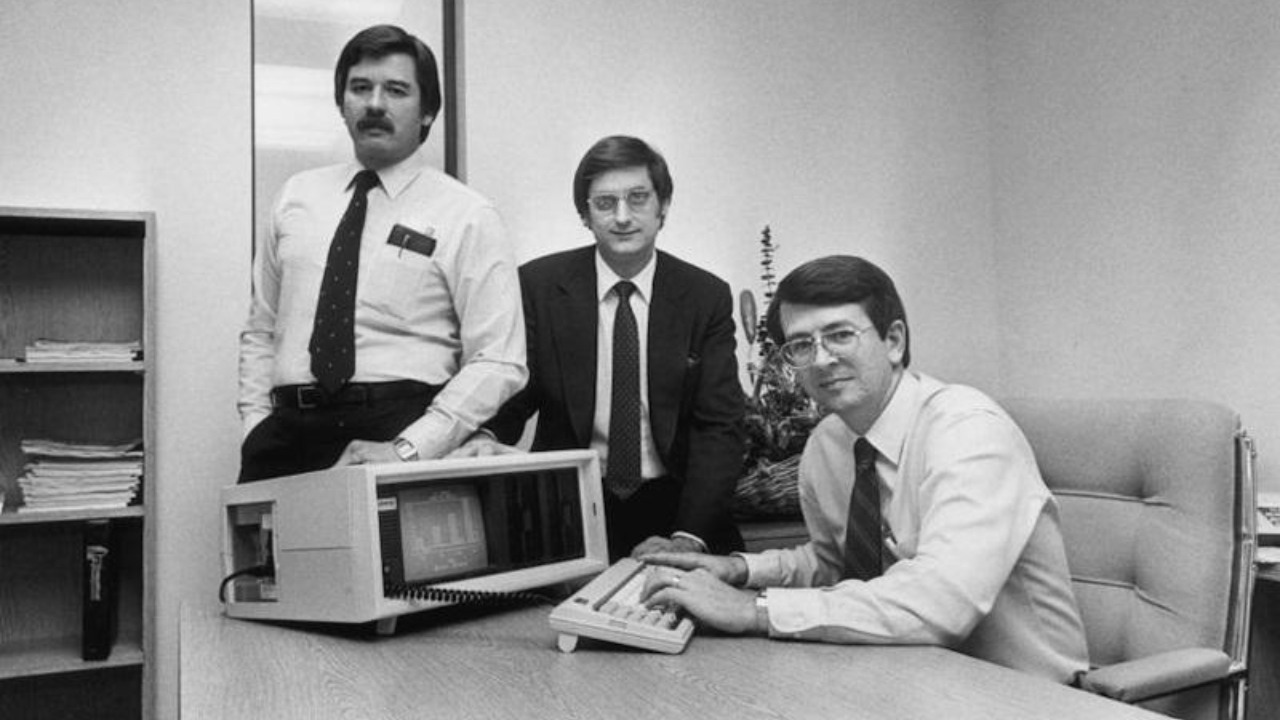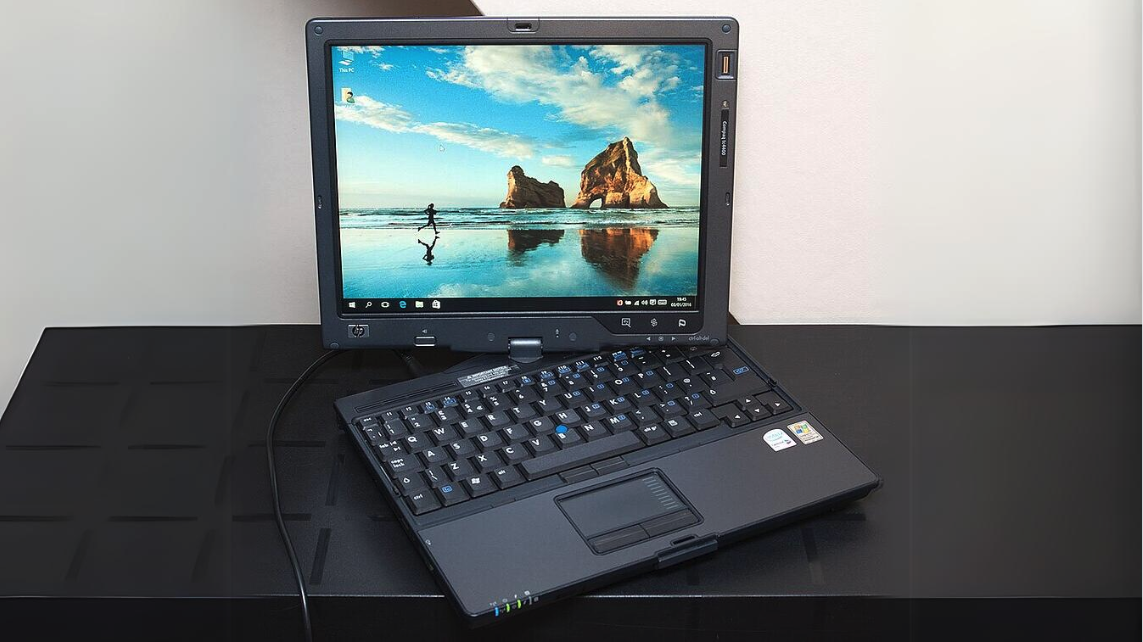No company dominated the early computing scene like Compaq. From its Compaq Portable to Compaq SLT and LTE, the computing giant created the industry’s most successful personal computers and notebook computers of the 80s and 90s, growing to become the world’s largest supplier of PC systems until 2001.
The company even created the first IBM PC-compatible computers ever sold and was the second company to ever legally reverse engineer the BIOS of the IBM personal computer.
With such a legacy behind it, you’d think Compaq would be thriving. But in the age of smartphones, laptops, and powerful computers at our fingertips, the company has instead been left in the dust of the computing revolution.
So what happened to Compaq, and what led to its downfall?
This article explores the rise, fall and eventual failure of Compaq, exploring what happened to the computing giant and how it became the forgotten name it is today.

What was Compaq?
Compaq was a pioneering American computer company founded in 1982 by Rod Canion, Jim Harris, and Bill Murto. It made its mark by developing some of the first machines compatible with IBM PCs, then the dominant force in personal computing.
Compaq was among the first companies to successfully reverse engineer the IBM PC's design, allowing their computers to run the same software as IBM's machines.

IBM was the dominant force in PCs at the time, but their machines were too expensive for the average person to afford.
Compaq began selling IBM-compatible machines at a much more affordable price for many users, helping it gain market share and challenge IBM's dominance.
The rise of Compaq
Compaq's biggest early success was the launch of the Compaq Portable in 1983. This machine, though bulky by today's standards, was considered a portable computer at the time and offered greater mobility than the desktop IBM PCs.
The Compaq Portable helped establish Compaq as a leader in portable computing, a market segment that would become increasingly important as computers became more mainstream across the globe.
In 1989, Compaq brought the first EISA system to market. That same year the company eclipsed Apple Computer (now Apple) as the number two supplier of personal computers behind IBM.
In 1991 the worldwide economic recession and the Persian Gulf War hurt Compaq’s profits and pummeled its stock price, leading to the ouster of cofounder and chief executive officer Rod Canion.
He was replaced by Compaq’s long-serving European sales and marketing leader, Eckhard Pfeiffer, who had been made chief operating officer and heir apparent after the 1990 retirement of Bill Murto, another co-founder.
Under Pfeiffer, the company laid off 1,700 employees and aggressively cut prices to shore up market share declines, and it also introduced a variety of lower-priced portable and desktop computers, servers, and printers.
One of these was the Compaq LTE Series, which built upon the legacy of the Compaq Portable and offered a more compact and lightweight design. The LTE series catered to the growing demand for true portable computing for business and personal use, and became one of the first commercially successful notebook computers in history.

Compaq also launched a multimedia line of PCs called Compaq Presario in 1991 as home computers began to become increasingly common.
The Presario was one of the first computers to offer features like sound cards, CD-ROM drives, and bundled software, making it a popular choice for families and home users who wanted an all-in-one entertainment and productivity machine.
By 1993 Compaq was the number one supplier of portable computers in America, and in 1995 it passed IBM to become the biggest seller of PCs worldwide.
The Fall of Compaq
Encouraged by the long economic expansion of the 1990s, Compaq decided to compete more broadly with IBM, the Hewlett-Packard Company, and Sun Microsystems turning its attention to mainframe computers.
As a first step to do this, it purchased mainframe manufacturer Tandem Computers for approximately $3 billion in 1997 and then bought Digital Equipment Corporation for $9.6 billion the following year.
This would come to backfire on Compaq. Cultural clashes and complexities in merging product lines between the three companies led to inefficiencies and internal confusion, leading to inefficiencies and internal conflicts.
At the same time, then CEO Pfeiffer switched the company’s long-standing retail strategy to a direct-marketing approach to fight growing competitive pressures from Dell and Gateway.
Dell's efficient direct sales model, allowing for lower prices and better customer service, was gaining traction. Compaq, initially reliant on traditional retail channels with less control over pricing, struggled to compete.
After less than two years, the company’s attempts to implement a direct sales model themselves proved unsuccessful. It has failed to beat even the number two mainframe computer company, Hewlett-Packard and was replaced as the top personal computer maker by Dell.
At the same time the PC market became increasingly price-competitive, and Compaq, with its established brand and sometimes higher costs, found it difficult to maintain margins.
Companies like Dell were more aggressive in pricing, putting even more pressure on a struggling Compaq to compete despite running out of money.
Then came the dot-com burst.
What happened to Compaq?
The dot-com burst would ultimately lead to Compaq's decline. Combined with their struggles with adapting to a changing market and problematic DEC acquisition, the dot-com burst weakened Compaq’s position in the PC market and led to their eventual acquisition by HP in 2002.
The dot-com boom could have been a massive growth opportunity for Compaq, but it failed to anticipate the massive demand for computers and didn't scale up production or adjust its marketing strategy to meet the needs of this booming market segment. This error would be the beginning of the end for the computing giant.
When the dot-com bubble finally burst, many startups folded, leading to a flood of used computers entering the market at significantly lower prices. These used machines, often sold at significantly lower prices, became a strong alternative to new Compaq computers. This sudden influx of used options dampened demand for new machines, leaving Compaq’s sales plummeting.
The dot-com bust also had a broader economic impact. Investor confidence weakened, and spending became more cautious. This general economic slowdown further hampered Compaq's ability to recover from the market saturation caused by used computers.
Does Compaq still exist today?
After being acquired by HP for $25 billion in 2002, Compaq stopped existing as a standalone company. HP continued continued to use the Compaq brand for several years after the acquisition for its lower-end PCs. But by 2013, it discontinued the Compaq brand entirely.

Since 2013, the Compaq brand has been licensed to third-party companies in some regions for use on electronics, but not with the same prominence it once held.
So, while you might see the Compaq name on some electronics in certain areas, it's not the same company that dominated the PC market in the 1980s and 1990s.







Comments ( 0 )